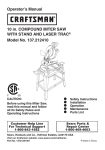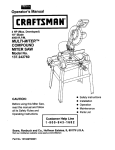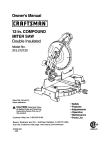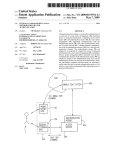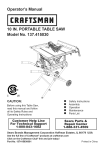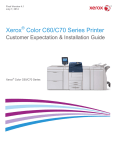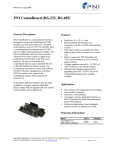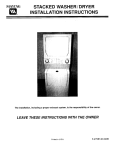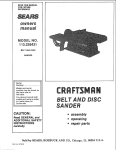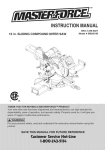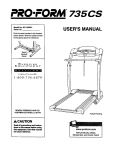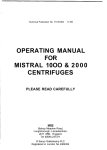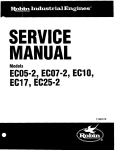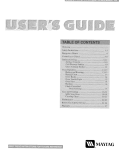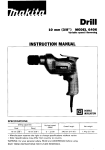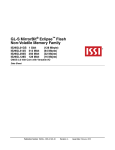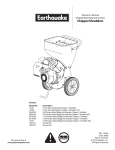Download Craftsman 137.212360 Operator`s manual
Transcript
Operator's Manual JCRHFTSMIIN°J 10 in. COMPOUND MITER SAW WITH LASER TRAC _ Model No..137.212360 CAUTION: Before using this Miter Saw, read this manual and follow all its Safety Rules and Operating Instructions Safety Instructions Installation • For Technical Support Customer Help Line 1-800-843-1682 Sears, Roebuck and Co., Hoffman Estates, IL60179 Visit our Craftsman website: www.sears.com/craftsman Part No. 13721236001 Operation Maintenance Parts List Sears Parts & Repair Center 1-800-469-4663 USA Printed in China SECTION PAGE warranty ............................................... Product Specifications .......................... 2 2 Symbols ................................................ Power Tool Safety ................................. Compound Miter Saw Safety ................. SECTION PAGE Know Your Compound Miter Saw .......... Glossary of Terms ................................. 10 11 3 Assembly and Adjustments ................... 12 4 6 Operation ............................................... Maintenance .......................................... 18 23 Electrical Requirements and Safety ...... Accessories and Attachments ............... 7 8 Troubleshooting Guide .......................... Parts List ................................................ 24 25 Tools Needed for Assembly .................. Carton Contents .................................... 8 9 Repair Protection Agreement .................. 28 CRAFTSMAN ONE YEAR FULL WARRANTY If this Craftsman tool fails due to a defect in material or workmanship within one year from the date of purchase, call 1-800-4-MY-HOME®to arrange for free repair(or replacement if repair proves impossible). This warranty applies for only90 days from the date of purchase if this product is ever used for commercial or rental purposes. This warranty does not includeexpendable parts, suchas lamps, batteries, bitsor blades. This warranty gives you specific legal dghts, and you may also have other rightswhich vary from state to state. Sears, Roebuck and Co., Hoffman Estates, IL 60179 _i, WARNING J Some dust created by using power tools contains chemicals known to the state of California to cause cancer and birth defects or other reproductive harm. Some examples of these chemicals are: • Lead from lead-based paints • Crystalline silica from bricks, cement and other masonry products • Arsenic and chromium from chemically treated lumber Your risk from these exposures varies, depending on how often you do this type of work. To reduce your exposure to these chemicals, work in a well ventilated area and work with approved safety masks that are MOTOR Cutting Power Source ................ 120V AC, 60Hz, 15 Amp Arbor Shaft Size ............ 5/8 in. Crosscut 2-5/8 in. x 5-1/2 in. Miter 450 R & L ................. 2-5/8 in. x 3-7/8 in. Speed ........................... 4800 RPM (No load) Brake ............................ Electric Double Insulated .......... No MITER SAW Bevel 45 ° L ....................... 1-1/2 in. x 5-1/2 in. Rotating Table: Diameter ........................... 10 in. Miter Detent Stops ....... Bevel Positive Capacity: ........................... 45 ° Miter and 45 ° Bevel .... 1-1/2 in. x 3-7/8 in. BLADE 0 °, 15 °, 22.5 °, 31.6 °, 45 ° R & L Arbor ................................. 5/8 in. Stops .... 0 °, 45 ° L IA WARNING J To avoid electrical hazards, fire hazards or damage to the tool, use proper circuit protection, This tool is wired at the factory for 110-120 Volt operation. It must be connected to a 110-120 Volt / 15 Ampere time delay fuse or circuit breaker, To avoid shock or fire, replace power cord immediately if it is worn, cut or damaged in any way. Before using your tool, it is critical that you read and understand these safety rules. Failure to follow these 2009/03 rules could result in serious injury n 2to--damage - to the tool. I WARNING ICONS Your power tool and its Operator's Manual may contain "WARNING ICONS" (a picture symbol intended to alert you to, and/or instruct you how to avoid, a potentially hazardous condition). Understanding and heeding these symbols will help you operate your tool better and safer. Shown below amsome of the symbols you may see. SAFETY ® ALERT: Precautions that involve your safety. PROHIBITION WEAR EYE PROTECTION: Always wear safety goggles or safety glasses with side shields. READ AND UNDERSTAND INSTRUCTION MANUAL: To reduce the risk of injury, user and all bystanders must read and understand instruction manual before using this product, ® KEEP HANDS AWAY FROM BLADE: will result in serious personal injury. SUPPORT I,A DANGER IA WARNING] AND CLAMP I Failure to keep your hands away from the blade WORK DANGER: indicates an imminentlyhazardous situation which, if not avoided, will result in death or serious injury. WARNING: indicates a potentially hazardous situation which, if not avoided, could result in death or serious injury. I,& CAUTION I CAUTION: indicates a potentially hazardous situation which, if not avoided, may result in minor or moderate injury. I CAUTIONI CAUTION: hazardous damage. IIIIIIIII IIIIIIIIII IIII used without the safety alert symbol indicates a potentially situation which, if not avoided, may result in property I 3 III III III GENERAL SAFETY INSTRUCTIONS BEFORE USING THIS POWER TOOL Safety isacombination ofcommon sense, staying alert andknowing how touseyour power tool. [_IL WARNING] To avoid mistakes that could cause serious Injury, do not plug the tool in until you have read and understood the following. 1. _ READ and become familiar with the entire Operator's Manual. LEARN the tool's application,limitationsand possiblehazards. The table on page 7 shows the correct size to use depending on cord length and nameplate ampere rating.If in doubt, use the next heavier gauge. The smallerthe gauge number, the heavier the cord. 11.WEAR PROPER APPAREL. Do not wear loose clothing,gloves, neckties, rings, bracelets or otherjewelry which may get caught in moving parts. Nonslip footwear is recommended. Wear protectivehair covering to contain long hair. 12.ALWAYS WEAR EYE PROTECTION. Any intothe eyes and could cause ower tool can foreignobjects permanent eye throw damage. ALWAYS wear Safety Goggles (not glasses) that complywith ANSI Safety standard Z87.1. Everyday eyeglasses have only impactresistant lenses. They ARE NOT safety glasses. Safety Goggles are available at Sears. NOTE: Glasses or goggles not in compliance with ANSI 7.87.1 could seriously injure you"when they break. O 2. KEEP GUARDS IN PLACE and in working order. 3. REMOVE ADJUSTING KEYS AND WRENCHES. Form the habit of checking to see that keys and adjusting wrenches are removed from the tool before turning ON. 4. KEEP WORK AREA CLEAN, Cluttered areas and benches invite accidents. 5. DO NOT USE IN DANGEROUS ENVIRONMENTS. Do not use power tools in damp locations,or expose them to rain or snow. Keep workarea well lit. 13.WEAR A FACE MASK OR DUST MASK. Sawing operation producesdust. 14.SECURE O 6. KEEP CHILDREN AWAY. All visitorsand bystandersshould be kept a safe distance from work area. 7. MAKE WORKSHOP CHILD PROOF with padlocks, master switchesor by removing starter keys. 8. DO NOT FORCE THE TOOL. It will do thejob better and safer at the rate for which it was designed. 9. USE THE RIGHT TOOL. Do not force the tool or an attachment to do a job for which it was not designed. 10.USE PROPER EXTENSION CORDS. Make sure your extension cord is in good condition. When using an extensioncord, be sure to use one heavy enough to carry the current your productwill draw. An undersizedcord will result in a dropin line voltageand in loss of power whichwill cause the toolto overheat. III IIIIIIII III I WORK, Use clamps or a vise to than using your hand and it frees old work when practical. It is safer both hands to operate the tool. 15.DISCONNECT TOOLS FROM POWER SOURCE before servicing,and when changing accessories such as blades, bits and cutters. 16.REDUCE THE RISK OF UNINTENTIONAL STARTING, Make sure switch is in the OFF position before plugging the tool in. 17.USE RECOMMENDED ACCESSORIES. Consult this Operator's Manual for recommended accessories. The use of improper accessories may cause risk of injury to yourself or others. 18.NEVER STAND ON THE TOOL. Serious injury could occur if the tool is tipped or if the cutting tool is unintentionally contacted. 19.CHECK FOR DAMAGED PARTS, Before further use of the tool, a guard or other part that is damaged should be carefully checked 4 ---_ III todetermine that it will operate properly and perform its intended function - check for alignment of moving pads, binding of moving parts, breakage of pads, mountingand any other conditionsthat may affect its operation. A guard or other part that is damaged should be properly repaired or replaced. 20,NEVER LEAVE THE TOOL RUNNING UNATTENDED. TURN THE POWER "OFF". Do not walk away from a running tool untilthe blade comes to a complete stop and the tool is unpluggedfrom the power soume. 21,DO NOT OVERREACH. Keep proper footing and balance at all times. 22,MAINTAIN TOOLS WITH CARE. Keep tools sharp and clean_forbest_ performance,Follow instructionsfor lubricatingand changing accessories, 23,WARNING: Dust generated from certain materials can be hazardous to your health. Always operate saw in well-ventilated area and provide for proper dust removal. 24.1A DANGER I People with electronic devices, such as pacemakers, should consult their physician(s) before using this product. Operation of electrical equipment in close proximity to a heart pacemaker could cause interferenceor failure of the pacemaker. SPECIFIC SAFETY INSTRUCTIONS FOR THIS COMPOUND MITER SAW 1. DO NOT USE THIN KERF BLADES they can deflect and contact guard and can cause possible injury to the operator. stop before returningthe saw to the raised position. 20. MAKE SURE the blade has come to a complete stop before removingor secudng the workpiece, changing the workpiece angle or changing the angle of the blade. 2. DO NOT operate the miter saw until it is completely assembled and installed according to these instructions. 21. NEVER cut metals or masonry productswith thistool. This miter saw is designedfor use on wood and wood-like products. 3. IF YOU ARE NOT thoroughly familiar with the operation of miter saws, seek guidance from your supervisor, instructor or other qualified person. 22. NEVER cut small pieces. If the workpiece being cut would cause your hand or fingers to be within 6-3/4 in. of the saw blade the workpiece is too small. 4. ALWAYS hold the work firmly against the fence end table. DO NOT perform any operation free hand (use clamp wherever possible). 23. PROVIDE adequate support to the sides of the saw table for long work pieces. 24. NEVER use the miter saw in an area with flammable liquidsor gases. 5, KEEP HANDS out of the path of the saw blade. If the workpiece you are cutting would cause your hands to be within 6-3/4 in. of the saw blade, the workpiece should be clamped in place before making the cut. 6. BE SURE the blade is sharp, is free of vibration. 7. ALLOW the motor to come up to full speed before starting a cut. 8. KEEP THE MOTOR AIR SLOTS CLEAN and free of chips or dust. 9. ALWAYS MAKE SURE all handles are tight before cutting, even if the table is positioned in one of the positive stops. 25. NEVER use solvents to clean plasticparts. Solvents could possiblydissolveor otherwise damage the material. 26. SHUT OFF the power before servicingor adjustingthe tool. 27. DISCONNECT the saw from the power source and clean the machinewhen finished using. 28. MAKE SURE the work area is clean before leaving the machine. runs freely and 29. SHOULD any part of your miter saw be missing,damaged, or fail in any way, or any electricalcomponent fail to perform properly, lock the switch and remove the plugfrom the power supply outlet. Replace missing, damaged, or failed parts before resuming operation. 10. BE SURE both the blade and the collar are clean and the arbor bolt is tightened securely. 11. USE only blade collars specified for your saw. 12. NEVER use blades larger in diameter than 10 inches. POWER SUPPLY AND MOTOR SPECIFICATIONS The AC motor used in this saw is a universal, nonreversible type. See "MOTOR" in the "PRODUCT SPECIFICATIONS" section on page 2. 13. NEVER apply lubricants to the blade when it is running, 14. ALWAYS check the blade for cracks or damage before operation. Replace a cracked or damaged blade immediately. 15. NEVER use blades recommended for IA WARNINGI operation at less than 4800 RPM. 16. ALWAYS keep the blade guards in place and use at all times. 17. NEVER To avoid electrical hazards, fire hazards, or damage to the tool, use proper circuit protection. Your saw is wired at the factory for 120 V operation. Connect to a 120 V, 15 A circuit and use a 15 A time delay fuse or circuit breaker. To avoid shock or fire, If power cord is worn or cut, or damaged in any way, have it replaced immediately. reach around the saw blade. 18. MAKE SURE the blade is not contacting the workpiece before the switch is turned ON. 19. IMPORTANT: After completing the cut, release the trigger and wait for the blade to 6 ...... [.... GROUNDING INSTRUCTIONS NOTE: When using an extension cord on a circuit with a #14 wire, the extension cord must not exceed 25 feet in length. Before connecting the motor to the power line, make sure the switch is in the off position and the electric current is rated the same as the current stamped on the motor nameplate. Running at a lower voltage will damage the motor. This tool is intended for use on a circuit that has a receptacle like the one illustrated in Fig. 1. IN THE EVENT OF A MALFUNCTION OR BREAKDOWN, grounding provides a path of least resistance for electric currents and reduces the risk of electric shock. This tool is equipped with an electrical cord that has an equipmentgrounding conductor and a grounding plug. The plug must be plugged into a matching receptacle that is properly installed and grounded in accordance with all local codes and ordinances. Fig. 1 shows a three-pronged electrical plug and receptacle that has a grounding conductor. If a properly grounded receptacle is not available, an adapter (Fig. 2) can be used to temporarily connect this plug to a two-contact grounded receptacle. The adapter (Fig. 2) has a rigid lug extending from it that MUST be connected to a permanent earth ground, such as a properly DO NOT MODIFY THE PLUG PROVIDED. If it will not fit the receptacle, have the proper receptacle installed by a qualified electrician, IMPROPER CONNECTION of the equipment groundingconductorcan result in riskof electric shock. The conductorwith the green insulation (with or withoutyellowstripes) is the equipment groundingconductor. If repairor replacement of grounded receptaclebox. or IAWARNiNG I the equipment groundingconductorto a oorv_'t live terminal. In all cases, make certain the receptacle is properly grounded. If you are not sure, have a qualified electrician check the receptacle. CHECK with a qualifiedelectricianor service person if youdo not completely understandthe groundinginstructions,or if you are not certain the tool is properlygrounded. [A WARNING l This tool is for indoor use only. Do not expose to rain or use in damp locations. USE onlythree-wire extensioncords that have three-prongedgroundingplugswith three-pole receptacles that accept the tool'splug. Repair or replace damaged or worn cords immediately. Fig. 1 GUIDELINES FOR EXTENSION CORDS Fig. 2 IIground ...-_ U/" - III II _ Adapter Two-Pronged Receptacle IA WARNING [ This tool must be grounded while in use to irotect the operator from electric shock. iil,e] =-illi_ll r,_,_.vll (When usin_l 120 volts only) Use a separate electrical circuit for your tool. This circuit must not be less than #12 wire with a 20 A time-lag fuse or a #14 wire with a 15 A time-lag fuse. III ProperlyGrounded Three-Pronged Receptacle GroundingLug_ Make sure this ! I(_"l II iSconnected _i-!.L ! "_'_l_lJ_ to a known Make sure your extension cord is properly wired and in good condition.Always replace a damaged extensioncord or have it repaired by a qualifiedtechnician beforeusing it. Protectyour extensioncords from sharp objects, excessive heat and damp or wet areas. II Plug II'-0AJ Lrounding Prong USE THE PROPER EXTENSION CORD. Make sure your extensioncord is in good condition. Use an extensioncord heavy enough to carry the current your productwill draw. An undersized cord will cause a dropin line voltage resulting in loss of power, overheating and burningout of the motor.The table on the rightshows the correct size to use dependingon cord length and nameplate ampere rating.If in doubt,use the next heaviergauge. The smallerthe gauge number, the heavier the cord. III _i1 _:_:ee-Pronged 7 _e,][e,] :k'.,5.-,[e] -i i :[..,fzl _i elz| RECOMMENDED I,_ • • ii IVzTI,];i_v_ i:1_| i munro_o] nk,'ln +l=1:lm:lntl=+o] :ir;1.-,_-_:lm i=]m¥_ SUPPLIED ACCESSORIES WARNING NOT SUPPLIED I Use only accessories recommended for this miter saw. Follow instructions that Blade Wrench accompany accessories. Use of Improper acceseorles may cause hazards. The use of any cutting tool except 10 in. Adjustable Wrench =====J saw blades which meet the requirements under recommended accessories is ::::::::::::::::::::: Hex Key Combination Square prohibited. Do not use accessories such as shaper cutters or dado sets. Ferrous metal cutting and the use of abrasive wheels is prohibited. • Do not attempt to modify this tool or create accessories not recommended Philips Screwdriver for Slotted Screwdriver use with this tool. Any such alteration or modification is misuse and could result in a hazardous serious condition leading to possible injury. ACCESSORIES Visit your Sears Hardware Department or see the Sears Power and Hand Tool Catalog to purchase recommended accessories for this power tool. COMBINATION • MUST BE TRUE Should not gap or overlap when square is flipped over (see dotted figure). [A, WARNING] • SQUARE To avoid the risk of personal injury, do not modify this power tool or use accessories Straight edge or a 3/4 in. board, this edge must be perfectly straight. Draw light line on board along this edge. not recommended by Sears. Read warnings and conditions on your CARBIDE TIPPED SAW BLADE. Do not operate the saw without the proper saw blade guard in place. Carbide is a very hard but brittle material. Care should be taken while mounting, using, and storing ji carbide Upped blades to prevent accidental damage. Slight shocks, such as striking the tip while handling, can seriously i f ! I // damage the blade. Foreign objects in the workpiece, such as wire or nails, can also cause tips to crack or break off. Before using, always visually examine the blade and tips for bent blade, cracks, breakage, missing or loose tips, or other damage. Do I I L not use if damage is suspected. Failure to heed safety instructions and warnings can result in serious II Gap from untrue square when . flipped over. bodily injury. 8 !11 _ I IIII flllllllll UNPACKING YOURMITER SAW 2. Place the saw on a secure stationarywork surface. IA WARNING I 3. Separate all parts from the packingmaterial. Check each of the illustrationsshown below to make certain all items are accounted for, before discardingany packing material To avoid injury from unexpected starting or electrical shock, do not plug the power cord into a source of power during unpacking and assembly. This cord must remain unplugged whenever you are working on the saw. I,A WARNING I If any part is missing or damaged, do not attempt to assemble the miter saw, or plug In the power cord untll the mlssing or damaged part Is correctly replaced. To avoid electric shock, usa only Identical replacement parts when servicing double insulated tools. Call 1-800-4-_AY-HOM_ for replacement parts. 1. Remove the miter saw from the carton. iMPORTANT: Do not lift miter saw by the trigger switch handle. It may cause misalignment. Lift machine by the built-in carry handle. .._J Hex Key Hold-Down Clamp Miter Table Handle Dust Bag Blade Wrench Miter Saw Batteries Rear Extension Stay II III 9 IJ IIIII Safety Lock-Off Button U Cover Plate Bevel Positive Stop Locking Lever Hand Hold for Transportation Miter Angle Pointer -Miter Lock Handle ON/OFF Arbor Laser On/Off Switch Latch Bevel Lock Handle Miter Rear Extension Stay Table Insert Hand Holdfor Transportation 10 II COMPOUND MITER SAW TERMS on machineand legible. ARBOR LOCK - Allows the user to keep the blade from rotating while tightening or loosening the arbor bolt during blade replacement or removal. WRENCH STORAGE - Convenient storage to prevent misplacingthe blade wrench. BASE - Supports the table, holds accessories and allows for workbench or leg set mounting. ARBOR mounted. BEVEL LOCKING HANDLE - Locks the miter saw at a desired bevel angle. BEVEL CUT - An angle cut made through the face of the workpiece. BEVEL SCALE -To measure the bevel angle of the saw blade 0° to 45° left. COMPOUND CUT - A simultaneous bevel and miter cut. COVER PLATE SCREW - Loosen this screw and rotate the plate for access to the blade arbor bolt. CROSS CUT - A cut made across the width of the workpiece. WOODWORKING TERMS - The shaft on which a blade is FREEHAND" Performing a cut without using a fence (guide), hold down or other proper device to prevent the workpiece from twistingduring the cuttingoperation. FENCE - Helps to keep the workpiece from moving when sawing. Scaled to assist with accurate cutting. LOWER BLADE GUARD - Helps protect your hands from the blade in the raised position, it retracts as the blade is lowered. GUM - A stickysap from wood products. MITER HANDLE - Used to rotate the table, and to rotate the saw to a right or left cutting position. KERF - The amount of material removed by blade cut. MITER SCALE - Measures 45 ° left and dght. MITER CUT - An angle cut made across the width of the workpiece. MOUNTING HOLES a stable surface. HEEL - Misalignment of the blade. the miter angle 0 ° to - To mount the miter saw to RESIN - A sticky sap that has hardened. REVOLUTIONS PER MINUTE (RPM) - The number of turns completed by a spinning object in one minute. ON/OFF TRIGGER SWITCH - To start the tool, squeeze the trigger. Release the trigger to turn off the miter saw. POSITIVE STOP LOCKING LEVER - Locks the miter saw at a preset positivestop for the desired miter angle. SAW BLADE PATH - The area of the workpiece or table top directly in line with the travel of the blade or the part of the workpiece which will be cut. STOP LATCH - Locks the miter saw in the lowered position for compact storage and transportation. SET - The distance between two saw blade tips, bent outward in opposite directions to each other. The further apart the tips are, the greater the set. SWITCH WORKPIECE - The item being cut. The surfaces of a workpiece are commonly referred to as faces, ends and edges. HANDLE - The switch handle contains the trigger switch and blade is lowered into down on the handle. upright position when the laser on/off switch. The the workpiece by pushing The saw will return to its the handle is released. WARNING LABELS - Read and understand for your own safety. Make sure all labels are present I II I III IIII III I 11 I IIII II IIIII I INSTALLING THE MITER HANDLE (FIG. A) 1. Thread the miter handle (1) into the hole (2) located at the front of the miter table. INSTALLING 1. Squeeze bag(1). 2. Fig. A THE DUST BAG (FIG. C) the metal collar wings (2) of the dust Place the dust bag neck opening around the exhaust port (3), and release the metal collar wings. Fig. C IA WARNING I To avoid injury and damage to the saw, transport or store the miter saw with the cutting head locked in the down position. Never use the stop latch to hold the cutting head in a down position for cutting operations. CUTTING HEAD (FIG. B) Raising the Cutting Head 1. Push clown slightly on the switch handle (1). 2. Pull the hold-down latch (2) out of the long slot (5) of locking hole (3) and turn 90 ° to insert into the short slot (6). 3. Pull up the switch handle (1) to raise to the up position. Fig. B Locking Cutting Head in Down Position When transporting or storing the miter saw, the cutting head should always be locked in the down position. 1. Push the switch handle (1) down to its lowest position. 2. Pull the hold-down latch (2) out of the short slot (6) of the locking hole (3) and turn 90 ° to insert into the long slot (5). IMPORTANT: To avoid damage, never carry the miter saw by the switch handle, the cutting arm or the miter handle. ALWAYS use the designated carrying handle (4). III IIIIIIIII III I I 12 INSTALLING THE REAR EXTENSION STAY (FIG. D) I. Loosen the extension stay lockingscrew (I) under the saw base (2). 2. Place the rear extension stay (3) into the holes provided in the miter saw base. Make sure the angle of stay is in the down position (as shown in Fig. D) for maximum support. 3, Insert the extension stay locking screw back to hole and tighten to hold the extension. Fig. O I 3 INSTALLING THE HOLD-DOWN CLAMP ASSEMBLY (FIG. E) 1. Loosen the lock knob (3) from the rear side of the saw base (4). 2. Place the hold-down clamp assembly (1) in one of the mounting holes (2), 3, Tighten the lock knob (3). III Fig.E 2 REMOVING OR INSTALLING THE BLADE ] A, WARNING] Only use a 10-inch diameter blade. To .avoid injury from an accidental start, make sure the switch is in the OFF position and plug iS not connected to the power source outleL Removing Blade (Fig. G, H, I) 1 Unplug the saw from the outlet. 2 Allowthe cuttinghead to riseto the upright position. Raise the lower blade guard (1) to the up position.(Fig. G) 3 Loosen the cover plate screw (2) with a Phillipsscrewdriver. 4. Rotate the cover plate (3) towardsthe rear of the tool to expose the arbor bolt (4). 5. Place the blade wrench over the arbor bolt. Fig. G INSERTING AND REPLACING THE LASER BATrERIES (FIG. F) • Unplug your miter saw. IAWARNING l Failure to unplugyour tool could result in accidental startingcausing possibleserious personal injury. 1. Remove the lockingscrew (1) on the batterycover (2) with a Phillips screwdriver, and open the cover. 2. Insert the two supplied AAA batteries in the case as per the diagram below. If replacing the batteries, take out the old batteries and place with new AAA batteries. Dispose of old batteries properly. 3. Put on the battery cover, replace the locking screw and tightenit securely. NOTE: Replace the batteries with batteries that have a rating of 1.5 volts(Number 4 series and AAA size or equivalent). Locate the arbor lock (5) on the motor,below the switch handle. (Fig. H) 7. Press the arbor lock, holding it in firmly while turning the blade wrench clockwise. The arbor lock will engage after turning the wrench. Continueto hold the arbor lock in to keep it engaged, while turningthe ,wrench clockwise to loosen the arbor bolt. 6. Fig. H Fig, F 5 8. I II Remove the arbor bolt (8), outer blade collar (6), and the blade (7). Do not remove the inner blade collar. (Fig. I) 13 JllllI III -- NOTE: Pay attention tothepieces removed, the table and check for any contact noting their position anddirection they face. the metal base or the tum table. Wipe theblade collars clean ofanysawdust ADJUSTMENT INSTRUCTIONS before installing thenew blade. IA, WARNING J Fig.I To avoid Injury from an accidental start, make sure the swItch is in the OFF position and the plug is not connected to the power source outlet. ,7 Installing Blade (Fig. G, H, I) 1. Install a 10 in. blade with a 5/8 in. arbor making sure the rotationarrow on the blade matches the clockwise rotation arrow on the upper guard, and the blade teeth are pointing downward. 2. Place the blade collar (6) against the blade and on the arbor. Thread the arbor bolt (4) onto the arbor in a counterclockwisedirection. (Fig. G) IMPORTANT: Make sure the flats of the blade collars are engaged with the fiats on the arbor shaft. Also, the flat side of the blade collar must be placed againstthe blade. 3. Place the blade wrenchon the arbor bolt. 4. Press the arbor lock (5), holding it in firmly while turningthe blade counterclockwise. When arbor lockengages, continue to press it in while tightening the arbor bolt securely. (Fig. H) . 5. Rotate the cover plate (3) back to its odginal positionuntil the slot in the cover plate engages with the cover plate screw (2). While holdingthe lower blade guard,tightenthe screw with a Phillipsscrewdriver.(Fig. G) NOTE: The lower blade guard must be raised to the upright position to access the cover plate screw. 6. Lowerthe blade guard (1) and verify that the operation of the guarddoes not bind or stick. 7. Be sure the arbor lockis released so the blade tums freely. A • WARNING AD,iUSTING FENCE SQUARENESS (FIG. J) I. Loosen the three fence lockingbolts(I). 2. Lower the cuttingarm and lock in position. 3. Using a square, lay the heel of the square againstthe blade, and the rule agaist the fence(2) as shown. Check to see if the fence is 90° to the blade. 4. If not, adjust fence 90° to the blade and tighten the fence lockingbelts. CAUTION: If the saw has not been used recently, recheckblade squareness to the fence and readjust if needed. 5. After fence has been aligned, usinga scrap piece of wood, make a cut at 90° then check squareness on the piece. Readjust if necessary. Fig. J MITER SCALE (FIG. K) The miter scale assists the user in setting the desired miter angles from 45° left to 45° right.The miter saw table has nineof the most common angle setttingswith positive stops at 0 °, 15°, 22.5 °, 31.6°, and 45°. These positive stopsposition the blade at the desired angle quickly and accurately. To Adjust the Angle: 1. Unlockthe miter table by turningthe miter handle (1) counterclockwise. 2. Press down the positivestop lockinglever (2) while holding the miter handle, and rotate the table leftor rightto the desired angle. 3. Release positive stop lockinglever. Tighten miter handle. 4. If the desired angle is one of the nine positive stops, release the positivestop lockinglever, making sure the lever snaps into position, and I To avoid Injury, never use the saw without the cover plate secure In place. It keeps the arbor bolt from failing out if it accidentally loosens, and helps prevent the splnning blade from comlng off the saw. • with Make sure the collars are clean and propsdyarranged. Lower the blade into 14 then secure by tightening the miter handle. 5. If the miter angle desired is not one of the nine positive stops, simply lock the miter table into position by turning the miter handle in the clockwise direction. To Adjust the Indicator: (1) Adjust the indicator (3) to the 0 o mark on the miter scale (4) to position the miter table. (2) Release positive stop locking Tighten miter handle. lever (2). Fig. K CUTTING ARM TRAVEL Cutting Arm Downward Travel Adjustment (Fig. L) I A WARNING I To avoid injury from unexpected stalling or electrical shock, turn the switch OFF and remove the power cord from the power source. BEVEL STOP ADJUSTMENT (FIG. M, N, O) I& WARNING I To avoid injury from unexpected starting or electrical shock, make sure the trigger is released and remove the power cord from the power source. 90 ° Bevel Adjustment (Fig, M) 1. Loosen bevel lock handle (1) and tilt the cuttingarm completelyto the right.Tighten the bevel lock handle. Lowerblade. 2. Place a combinationsquare (2) on the miter table with the rule againstthe table and the heel of the square against the saw blade. 3. If the blade is not 90° square with the miter table, loosen the bevel lock handle, tilt the cuttinghead completelyto the left, loosen the Iocknut(4) on the bevel angle adjustment bolt (3) and use a 13 mm wrench to adjust the bolt (3) in or out to increase or decrease the bevel angle. 4. Tilt the cutting arm to back to the right at 90° bevel and recheck for alignment. 5. Repeat steps t through 4 if further adjustmentis needed. 6. Tighten bevel lock handle and Iocknut (4) when alignment is achieved. Fig. M NOTE: Before each cutting operation, check the positionof the blade to make sure it does not contact any metal surface. If the blade contacts any metal surface, the depth of travel must be adjusted. 1. Lower the blade as far as possible. 2. Loosen the Iocknut (3). 3. Tum the adjustment bolt (4) out (counterclockwise)to decrease the cutting depth or in (clockwise)to increasethe cutting depth. 4. Carefully rotate the blade manually to check for contact. Avoid touchingblade points or edges. 5. Repeat untiladjusted properly, and tighten the Iocknut to secure the adjustment bolt into position. 1 Fig. L HI I - - 15_'::: ..... 90 ° Bevel Indicator (Fig. N) 1. When the blade is exactly 90° to the table, loosenthe bevel indicatorscrew (5) using a #2 Phillipsscrewdriver. 2. Adjust bevel indicator(6) to the =0"mark (7) on the bevel scale and retightenthe screw. MOUNTING THE MITER SAW (FIG. P, Q) I A, WARNING} To avoid injury from unexpected saw movement: • Before moving the saw, disconnect the power cord from the outlet, and lock the cutting arm in the lower position using the stop latch. NOTE: The stop |atch is for carrying or storing the tool. It is not to be used for holding the saw while cutting. Lower blade and press in stop latch to secure saw for transport or storage. • Never carry the miter saw by the power cord or by the switch handle. Carrying the tool by the power cord could cause damage to the insulation or wire connections resulting in electric shock or fire. • To avoid injury from flying debris, do not allow visitors to stand behind the saw. • Place the saw on a firm, level work-surface where there is room for handling and properly supporting the workpiece. • Support the saw on a level work surface. • Bolt or clamp the saw to its support. Fig. N 7------5/ 15° Bevel Adjustment (Rg. O) I. Unlock the bevel lock handle (1) and tiltthe cuttingarm as far to the left as possible. 2. Usinga combinationsquare, check to see if the blade angle is 45° to the table. 3. If the blade is not at 45° to the miter table, tilt the cuttingarm to the right,loosen the Iocknut(5) on the bevel angle adjustment bolt (4) and use a 13 mm wrench to adjust the bolt (4) in or out to increaseor decrease the bevel angle. 4. Tilt the cuttingarm to the leftto 45 ° bevel and recheckfor alignment. 5, Repeat steps 1 through4 untilthe blade is at 45 ° to the miter table. 6, Tighten bevel lock handle and Iocknut(5) when alignment is achieved. Place the saw in the desired location,either on a work benchor recommended leg set. The base of the saw has four mountingholes (10). (Fig. P) Mounting instructions 1. For stationary use, place the sew in the desired location, directly on a workbench where there is room for handling and proper support of the workpiece. The base of the saw has four mounting holes. Bolt the base of the miter saw (1) to the work surface (5), using the fastening method as shown in Fig P. Fig. P Fig. 0 1. 2. 3. 4, 5. 6, 7, 8, 9, Miter sew base Hex head bolt Rubberwasher Fiat washer Workbench Flatwasher Lockwasher Hex nut Jam nut 10 10 II IIIIIII II III 16 NOTE: Mountinghardware is not includedwith thistool. Bolts, nuts, washers, and screws must be purchas_l separately. 2. Laser Warning Label: Max output <SmW DIODE LASER: IS30-670nm, Complies with 21CFR 1040.10 and 1040. 11. For portable use, place the saw on a 314 in. thickpiece of plywood.Boltthe base of the miter saw securely to the plywoodusingthe mounting holes on the base. Use C-clamps to clamp this mountingboard to a stable work surface at the worksite. AVOIOI_'T EYEEXPO_IE OR_ _ FIADWION DmL_TLY WfllH 0PTiCAL Bd81RUMBMT_ Fig. Q C_ _1_ 21CFR10S.10I',d 10W.ll Cl*n k L_er Produd • \._ I& WARNING I Inch Plywood • IA • Hand Hold for Transportation • / THE LASER GUIDE (RG. R) 1. To turn laser on, tum switch(1)to "1"position. 2. To turn laser off, turn switchto "O" position. Use of controls or adjustments or performance of procedures other than those specified herein may result in hazardous radiation exposure. WARNING J The use of optical Instruments with this product will increase eye hazard. Do not attempt to repair or disassemble the laser. If unqualified persons attempt to repair this laser product, serious injury may resuIL Any repair required on this laser product should be performed by a Sears or other qualified service center. NOTE: All the adjustments for the operation of this machine have been completed st the factory. Fig. R+ Your tool is equipped with the Laser Guide usinga Class III laser beam. The laser beam will enable you to preview the sew blade path on the stock to be cut beforestartingthe miter saw. This laserguide is powered by two AAA 1.5 volt batteries. AVOID DIRECT EYE CONTACT A • WARNING I Laser is radiated when laser guide is turned on. Avoid direct eye contact. Always un-plug the miter sew from power source before making any adjustments. 17 IIIIII SAFETY INSTRUCTIONS FOR BASIC SAW saw is missing,bent, damaged or broken in any way, or any electricalparts don't work, turn the saw off and unplugit. Replace bent, damaged, missingor defective parts beforeusing the saw again. Maintaintools with care. Keep the miter saw clean for best and safest performance. Follow instructionsfor lubricating.Do not put lubricantson the blade while it is spinning. Remove adjusting wrenchfrom the toot before turning it on. To avoid injury from jams, slips, or thrown pieces, use only recommendedaccessories_ Check the dust bag before you work. Empty the bag if it is more than half-fulL OPERATION BEFORE USING THE MITER SAW • [_ • WARNING] To avoid mistakes that could cause serious, permanent injury, do not plug the tool in until the following steps are completed: • Completely assemble and adjUstthe saw, followingthe instructions.(ASSEMBLY AND ADJUSTMENTS) • Learn the use and functionof the ON/OFF switch, lock-off switch, upperand lower blade guards, hold down latch; bevel lock handle and cover plate screws. • Review and understand all safety instructions and operating procedures in thisOperator's Manual. (SAFETY & OPERATIONS) • Review the MAINTENANCE and TROUBLESHOOTING GUIDE foryour miter , • • • RECOMMENDED ACCESSORIES • Consult the ACCESSORIES and ATTACHMENTS sectionof this Operators Manual for recommendedaccessories. Follow the insb'uctionsthat come with the accessory, The use of improperaccessories may cause riskof injuryto persons. Choose the correct 10 in. diameter blade for the material and the type of cuttingyou plan to do. Do not use thin kerf blades. Make sure the blade is sharp, undamaged and properly aligned.With the saw unplugged,push the cuttingarm all the way down. Manually spinthe blade and check for clearance. Tilt the power-head to a 45° bevel and repeat the,test. Make sure the blade and arbor collarsare clean. Make sure all clamps and locks are tightand there is no excessive play in any parts. saw, • To avoid injuryor possibledeath from electricalshock: Make sure your fingersdo not touch the plug'smetal prongswhen pluggingor unpluggingyour miter saw. (ELECTRICAL EQUlREMENTS AND SAFETY) • • BEFORE EACH USE INSPECT YOUR SAW. • • • • • • II • Disconnect the miter saw, To avoid injury fromaccidental starting,unplugI_ saw before any adjustments, includingset-up and blade changes. Compare the direction of rotation arrow on the guard tothe directionarrow on the blade. The blade teeth should always point downward at the front of the saw. Tighten the arbor bolt, Tighten the cover plate screw, Check for damaged parts. Check for: • • Alignment of moving parts • Damaged eleCtriccords • Binding of moving parts • Mounting holes • Function of arm return springand lower guard: Push the cuttingarm all the way down, then let it rise untilit stops. The lower guard shouldfully close. Follow instructionsin TROUBLESHOOTING GUIDE for adjUstment if necessary. • Other conditionsthat may affect the way the miter saw works. Keep all guards in place, in workingorder and proper adjustment! If any part of this miter III • KEEP YOUR WORK AREA CLEAN Cluttered areas and benches invite accidents. l_, WARNING] To avoid burns or other fire damage, never use use the miter saw near flammable liquids, vapors, or gases. • Plan ahead to protectyour eyes, hands, face and ears. • Know your miter saw. Read and understand thisOperator,s Manual and labels affixed to this tool. Learn its application and limitations as well as the specificpotential hazards peculiarto this tool.To avoid injuryfrom accidentalcontact with moving parts, do not do layout,assembly, or setup workon the miter saw while any parts are moving. • Avoidaccidental starting,make sure the trigger switch is disengaged before plugging the miter saw into a power outlet. 18 II III IIII I1' I I'111111 IIq] PLAN YOUR WORK • Use the right tool. Don't force a tool or attachment to do a job it was not designed to do. Use a differenttool for any workpiece that can't be held in a solidly braced, fixed position. LA CAUTION I This machine is not designed for cutting masonry, masonry products, ferrous metals (steel, iron, and iron-based metals.) Use this miter sew to cut only wood, woodlike products, or non-ferrous metals. Other material may shatter, bind the blade, or create other dangers. Remove all nails that may be in the workpieee to prevent sparking that could cause a fire, Remove dust bag when cutting non-ferrous metals. • • • • Make sure there are no gaps between the workpiece, fence and table that will let the workplace shift after it is cut. Keep the cut off piece free to move sideways after it is cut off. Otherwise, it could get wedged against the blade and thrown violently. Only the workpiece should be on the saw table. Secure work. Use clamps or a vise to help hold the work when it's practical. USE EXTRA CAUTION WITH LARGE OR ODD SHAPED WORKPIECES. • Use extra supports(tables, sawhorses, blocks, etc.) for workpieces large enough to tip. • Never use another person as a substitute for a table extension, or as an additional support for a workpiece that is longer or wider than the basic miter saw table, or to help feed, support, or pull the workpiece. • Do not use this saw to cut small pieces. If the workpiece being cut would cause your hand or fingers to be within 6-3/4 inches of the saw blade the workpiece is too small. Keep hands and fingers out of the "no hands zone" area marked on the saw table. • When cuttingodd shaped workpieces, plan your work so it will not bind in the blade and cause possible injury. Molding, for example, must lie flat or be held by a fixture or jig that will not let it move when cut. • Properly support round material such as dowel rods, or tubing, which have a tendency to roll when cut, causing the blade to "bite". DRESS FOR SAFETY Any power tool can throw foreign objects into the eyes. This can result in permanent eye damage. Everyday eyeglasseshave onlyimpact resistantlenses and are not safety glasses. Glasses or goggles not in compliancewith ANSI Z87.1 could seriously injure youwhen they break. • Do not wear loose clothing,gloves, neckties or jewelry (rings,watches). They can get caught and draw you into moving parts. • Wear non-slipfootwear. • Tie back long hair. • Roll longsleeves above the elbow. • Noise levelsvary widely. To avoid possible hearing damage wear ear plugs when using any miter saw. • For dustyoperations, wear a dust mask along with safety goggles. 1_, WARNING INSPECT YOUR WORKPIECE Make sure there are no nails or foreign objects in the part of the workpiece beingcut. Plan your work to avoid small pieces that may bind,or that are too small to clamp and get a solidgrasp on. Plan the way you will grasp the workpiece from start to finish. Avoidawkward operationsand hand positions.A sudden slip could cause your fingers or hand to move into the blade. To avoid injury, follow all applicable safety instructions, when cutting non-ferrous metals: • Use only saw blades specifically recommended for non-ferrous metal cutting. • Do not cut metal workpieces that must be hand held. Clamp workpieces securely. • Cut non-ferrous metals only if you are under the supervision of an experienced person and the dust bag has been removed from the saw. DO NOT OVER-REACH Keep good footing and balance. Keep your face and body to one side, out of the line of a possible kickback. NEVER stand in the line of the blade. Never cut freehand: • Braceyour workpiece firmlyagainst the fence and table stopso it will not rock or twist during the cut. • Make sure there is no debris between the workplace and the tableor fence. ! ] WHEN SAW IS RUNNING J_ WARNING Do not allow familiarity from frequent use of your miter sew to result in a careless mistake. A careless fraction of a second is enough to cause a severe injury. Before cutting, if the saw makes an unfamiliar noise or vibrates, stop immediately. Turn the sew OFF. Unplug the sew. Do not restart until finding and correcting the problem. BODY AND HAND POSITION WARNING (FIG. S) I area. Proper positioning of your body Never place when handsoperating near the the cutting and hands miter saw will make cutting easier and safer. Keep children away. Keep all visitors at a safe distance from the miter saw. Make sure bystanders are clear of the saw and workpiece, Don't force the saw. It will do the job better and safer at its designed rate. Starting a cut: • Place hands at least 6-3/4 in. away from the path of the blade - out of the "no-hands zone" (1). (Fig. S) • Hold workpiece firmly against the fence to prevent movement toward the blade. • With the power switch OFF, bring the saw blade down to the workpiece to see the cutting path of the blade. • Press in lock-off switch in trigger switch handle, • Squeeze trigger switch to start saw. • Lower blade into workpiece with a firm downward motion. Finishing a cut: • Hold the cutting arm in the clown position. • Release trigger switch and wait for all moving parts to stop before moving your hands and raising the cutting arm. • If the blade doesn't stop within 6 seconds, unplug the saw and follow the instructions in TROUBLESHOOTING GUIDE section. Before freeing jammed material: • Release trigger switch. • Wait for all moving parts to stop. " • Unplug the miter saw, 1 Fig TURNING SAW ON (FIG. T) To reduce the likelihood of accidental starting, a thumb activated lock-OFF switch is located on top of the switch handle. The lock-OFF switch (1) must be pushed in before the trigger switch (2) can be activated and the miter saw started. WARNING I Make the switch child-proof, Insert a padlock through the hole (3) in the trigger switch and lock it. This will prevent children and other unauthorized users from engaging the trigger switch ON. Fig. T BEFORE LEAVING THE SAW • Never leave tool runningunattended.Turn power OFF. Wait for all moving parts to stop and unplugunit from power source. • Make workshopchild- proof. Lockthe shop, Disconnect master switches.Store tool away from children and other unqualifiedusers. MITER CUT (FIG. U) 1. When a miter cut is required, unlock the miter table by turning the miter handle (1) counterclockwise. 2. While holding the miter handle, press down on the positive stop locking.lever (2) to disengage the positive stop locking lever. 3. Rotate the miter table to the right or left with the miter handle. 4. When the table is in the desired position as shown on the miter scale (3), release the positive stop locking lever handle and tighten the miter handle. The table is now locked at the desired angle. Positive stops are provided at 0°,15 °, 22.5 ° , 31.6 ° and 45 ° . IMPORTANT: ALWAYS TIGHTEN the miter table lock handle before cutting. Fig. U : 6-3/4 in. ' ?' _ 6-3/4 in. 2 q] __ 2O BEVEL CUT (FIG. V) Fig. X 1. When a bevel cutis required, loosenthe bevel lock handle (1). 2. Tilt the cuttinghead to the desired angle as shown on the bevel scale (2), The blade can be positionedat any angle, from a 90° straight Hold-Dow_ cut (0 ° on the scale) to a 45 ° left bevel. 3. Tighten the bevel lock handle (1) to lockthe cuttinghead in position. 4. Positive stopsare providedat 0° and 45 °. Clamp Fig. COMPOUND CUT (FIG. W) A compound cut is the combinationof a miter and a bevel cut simultaneously. 1. Loosen the bevel lock handle (1) and position the cuttinghead at the desired bevel position. Lockthe bevel lock handle. 2. Loosen the miter table lock handle (2). Press down the positivestop lockinglever (3) and positionthe table at the desired angle. Release the positivestoplocking leverand lock the miter handle. Fig. W _ Workpi_ CUTTING BASE MOLDING (FIG. Y) Base moldings and many other moldings can be cut on a compound miter saw. The setup of the saw depends on moldingcharacteristicsand application,as shown. Perform practice cutson scrap material to achieve best results: 1. Always make sure moldings rest firmly against fence and table. Use hold-downor C-clamps, whenever possible,and place tape on the area being clamped to avoid marks. 2. Reduce splinteringby taping the cut area prior to making cut. Mark cut line directly on the tape. 3. Splinteringtypically happens due to wrong blade applicationand thinness of the material. Fig. Y Workpiece e Miter Saw Table I Miter Saw Table I m_r at 45°, beret at 0° miter at 0o,bevel at 45o " 1 NOTE: Always perform a dry run cut so you can determine if the operation being attempted is possible before power is applied to the saw. CUTTING CROWN MOLDING (FIG. Z, AA ) CUTTING BOWED MATERIAL (FIG. X) A bowed workpiece must be positioned against the fence and secured with a clamping device as shown before cutting. Do not position workpiece incorrectly or try to cut the workpiece without the support of the fence. This will cause the blade to bind and could result in personal injury. I II!1111 IHIIII Your compound miter saw is suited for the difficulttask of cuttingcrown molding.To fit propedy, crown molding must be compoundmiterd with extreme accuracy. __ . The two surfaces or1a piece of crowT_molding that fitflat against the ceiling and wall are at angles that, when added together equal exactly 90 ° , Most crown molding has a top rear angle [the section that fits flat against the ceiling) of 52 ° and a bottom rear angle (the section that fits fiat against the wall) of 38 ° . 21 IIIIIIIIIII II IIIIII NOTE: The chart below references a compound cut for crown molding ONLY WHEN THE ANGLE BETWEEN THE WALLS EQUALS EXACTLY 90°. In order to accurately cut crown molding for a 90 ° Inside or outside corner, lay the molding with its broad back surfaceflat on the saw table. When setting the bevel and miter angles for compoundmiters, rememberthat the settingsare interdependent;changing one changes the other, as well. I BEVEL I MITER SETTING Fig. Z IL 33.9° TYPE OF CUT 31.6 ° Right 1. Position top of molding _gatnst fence. 2. Miter table set at RIGHT 31,6 °, 3. LEFT side is finished piece. _ble I IR 33,9° 31,6 ° Left 1, Position bottom of molding ngalost 1enos, 2. Miter table set at LEFT 31.6 °, 3, LEFT side is finished piece. Outside €omer-L_t side Bevel/Miter Settings O!_ 33.9° 31,6 ° Left 1. Position bottom of molding against fence. Rg. AA 2. Miter table set at LEFT 31.6 °. Settings for standard crown molding lying flat on compound miter saw table OR 33.9° 31,S o R_ht 1. Positiontop of mddldg against fence. Inside Corner 2. Miter table set at RIGHT 31.6° , L RIGHT side is finished piece. Outside Comer I 22 MAINTENANCE A LOWER BLADE GUARD Do not use the saw without the lower blade guard. The lower blade guard is attached to the saw for your protection. Should the lower guard become damaged, do not use the saw untilthe damaged guard has been replaced. Develop a regular check to make sure the lower guard is working propedy.Clean the lower guard of any dust or buildup with a damp cloth. DANGER I To avoid injury, never put lubricants on the blade while it is spinning. WARNING I To avoid fire or toxic reaction, never usa gasoline, naphtha acetone, lacquer thinner or similar highly volatile solvents to clean the miter saw. !_ CAUTION: Do not use solventson the guard. The)/could make the plastic "cloudy_ and brittle. WARNING I,A WARNING To avoid injury from unexpected starting or electrical shock, unplug the power cord before workin9 on the saw. I_ WARNING I When cleaning the lower guard, unplug the saw from the power source receptacle to avoid unexpected startup. I EMPTYING SAWDUST BAG Periodically,sawdust will accumulate under the work table and base. This couldcause difficulty in the movement of the worktablewhen setting up a miter cut. Frequently blow out or vacuum up the sawdust. For your safety, this saw is doubis-insulsted. To avoid electrical shock, fire or Injury, use only parts identical to those identified in the parts list. Reassemble exactly as the original assembly to avoid electrical shock. IA WARNING I REPLACING CARBON BRUSHES (FIG. BB) Replace both carbon brushes when either has less than 1/4 in. length of carbon remaining, or if the spring or wire is damaged or burned. To inspect or replace brushes, first unplug the saw. Then remove the black plastic cap (1) on the side of the motor (2). Remove the cap cautiously, because it is springloaded. Then pull out the brush and replace. Replace for the other side. To reassemble reverse the procedure, The ears on the metal end of the assembly go in the same hole the carbon part fits into, Tighten the cap snugly, but do not overtighten. If blowing sawdust, wear proper eye protection to keep debris from blowing into eyes. LUBRICATION (FIG. CC) All the motor bearings in thistool are lubdcated with a sufficientamount of high grade lubricant for the life of the unit under normal operating conditions;therefore, no furtherbearing lubricationis required. Lubricatethe followingas necessary: Chop pivot: Apply light machineoil to points indicated in illustration. NOTE: To reinstall the same brushes,first make sure the brushes go back in exactlythe way they came out. This will avoid a break-in periodthat reduces motor performance and increases wear. Chop and Central pivot: Applylight machine oil to points indicated in illustration. Fig. CC Fig. BB Central pivot of plastic, Chop III 23 pivot III [_ WARNING] To avoid injury from accidental starting, always turn switch OFF and unplug the tool before moving, replacing the blade or making adjustments, TROUBLESHOOTING GUIDE - MOTOR PROBLEM PROBLEM CAUSE SUGGESTED CORRECTIVE ACTION Brake does not 1. Motorbrushes not sealed or lightly 1. Inspect/clean/replacebrushes. See MAINTENANCE section. stopthe blade sticking. within6 seconds. 2. Motor brake overheatedfrom use 2. Use a recommendedblade. Let cool down, See REMOVING OR INSTALUNG of defectiveor wrong size blade THE BLADE sectioh. or rapid ON/OFF cycling. 3. Arbor bolt loose. 3. Retighten. See REMOVING OR 4. Brushescracked, damaged, etc. INSTALLING THE BLADE section. 5. Other. 4. Replace brushes. 5. Contact Sears ServiceCenter. Motor does not 1. Limit switchfailure 1. Replace limitswitch. start 2. Brush worn. 2. Replace brushes. See MAINTENANCE 3. Fuse blown or circuitbreaker section. tripped on home panel. 3. Vedfy there is electricalpower at the outlet, B,rush spark 1. Brush worn. 1. Replace Brushes. See MAINTENANCE when switch 2. Other. section. released. 2. Contact Sears ServiceCenter. TROUBLESHOOTING GUIDE - sAw OPERATION PROBLEM PROBLEM CAUSE Biade hitstable. il Misalignment. _,ngle of cut not accurate. Can not adjust miter. SUGGESTED CORRECTIVE ACTION 1. See ADJUSTMENT - CuttingHead DownwardTravel Adjustmentsection. 1. See OPERATION - Miter Angle Adjustmentsection, 2. Vacuumor blowout dust.WEAR EYE PROTECTION. 1. Contact Sears Service Center, 1. Miter table unlocked. i2. Sawdust under table. ICutting arm Nobbles. il. Cutting ar_n will =not fully #aise, or blade guard iwon't fully close. Blade binds, ams, bums wood. 1, Pivot bolttoo tight. 1. 2. Pivot springnot replaced properly after service. 2. 3. Sawdust build-up. 3, 1. Improperoperation. 1. 2. Dull or warpedblade. 2. 3. Improperblade size. 3. 4 Wood is moving during cut. 4. Saw vibrates or shakes. 1. Saw blade not round / damaged / 1. Replace blade. loose, 2. Tighten arbor bolt. 2. Arbor Ix)it loose. TROUBLESHOOTING Loose pivot points. GUIDE - LASER Loosen pivotbolt lock nut (see adjustment section). Contact Sears Service Center. Clean and lubricate rnovin9 parts. See BASIC SAW OPERATION section. Replace or sharpen blade. Replace with 10in, diameter blade, Use holddown clamp to secure workpiece to table. GUIDE PROBLEM PROBLEM CAUSE SUGGESTED The laser guide fails to turn on, 1. The batteries are dead. 2. The batterycontactsneed adjustment. 1. Replace with new AAA batteries. 2. Reload the batteries and make certain that they make solid contact to the battery spring. IIIill IIIII!1111 I III 24 CORRECTIVE ACTION II IIII 10 in. COMPOUND MITER SAW MODEL NO. 137.212360 ill WARNING l When servicing use only CRAFTSMAN replacement parts. Use of any other parts many create a HAZARD or cause product damage. Any attempt to repair or replace electrical parts on this Miter Saw may create a HAZARD unless repair is done by a qualified service technician. Repair service is available PARTS LIST FOR SAW SCHEMATIC LD. Description X3P1 COMPRESSION t X3P2 BUTTON at your nearest Sears Service Size I.D. Description 1 X3RT COIL 1 X3RU PLASTIC 2 X3RV LOCK 1 X3S0 FLAT WASHER QTY SPRING SWITCH Centre. Slze SPRING QTY 1 SLEEVE 1 NUT M10 1 ¢10 2 X3P4 BATTERY X3P9 POWER X3PA SEGMENT 1 X3S2 POINTER X3PC MOTOR HANDLE (TOP) 1 X3S6 CR, X3PD MOTOR HANDLE (DOWN) 1 X3S7 SPRING X3PE CORD CLAMP 1 X3S8 POINTER X3PG CORD GUARD 1 X3SD REAR X3PH LIMIT SWITCH 1 X3SE CR. X3PJ HEX, HD. 1 X3SF BOLT X3PY CUTTER 1 X3$G FLAT X3Q0 CR. 1 X3SH SPRING X3QI SPRING GUARD 1 X3SJ FENCE X:3Q3 CR. RE. PAN HD. M5"6 4 X3SK MITER LOCK X3Q4 CR. RE. COUNT M6"12 1 X3SM FLAT WASHER X3Q5 RUBBER 1 X3SN SPRING X3Q6 COLLAR 1 X3SP CR. X3Q7 LOWER ! X3SQ SLIDE X3Q8 BRACING 1 X3SS BASE X3Q9 COLLAR 1 X3ST HEX. X3QA LOCK M6 1 X3T0 MOTOR X3QB CR, M6"12 1 X3T1 LASER ASS'Y X3OC COLLAR 1 X3T2 BEVEL LOCK X3QD FLAT 2 X3T3 ANGLE REGULATOR XSQW CR. i X3T4 HOLD X3R7 TRIGGER 1 X3T6 INSTRUCTION X3R8 BLADE 1 X3T8 BEVEL X3R9 ARBOR 2 X3T9 ROLLER X3RA ARBOR 1 X3TA CR. RE PAN HD TAPPING SCREW M6"18 2 X3RB BLADE 1 X3TB CR. RE, PAN HD. TAPPING SCREW M4"16 8 X3RG SHAFT ! X3TC CR. M5"40 2 X3RH TORSION 1 X3TF RETAINING X3RK CR. M5"10 1 X3TG DUST X3RL HEX. M8"20 2 X3TH LEVER X3RM NUT M8 2 X3TJ PIVOT X3RN LOCK NUT M8 1 X3TL CR. X3RP FLAT WASHER s8 ! X3W4 LABEL 1 X3RQ TABLE 1 X3W9 SCALE 1 X3RR CR, 4 X3WA LABEL 1 X3RS TABLE 1 X3WB HEX ...... CABLE HANDLE BOLT M6"14 SHAFT GUARD RE. COUNT HD. SCREW SCREW HD. SCREW M6"10 BLOCK BLADE GUARD PLATE NUT RE. PAN HD. SCREW WASHER RE, s6 COUNT HD. SCREW COLLAR BOLT M8"20 WRENCH SPRING RE. PAN HD. HD. SCREW BOLT INSERT RE. COUNT HD, SCREW M4"8 . ..... . _ 25 RE 1 PAN HD. SCREW WASHER M4"10 3 04 1 1 EXTENSION RE. PAN HD, STAY SCREW 1 M6"16 1 CLAMP M6"14 1 WASHER 08 3 s8 3 WASHER 1 HANDLE 1 WASHER RE, PAN HD, SCREW 04 1 05 2 M5"12 2 PLATE 3 1 HD. BOLT M8"30 ASS'Y DOWN 1 1 HANDLE CLAMP ASS'Y 1 ASS'Y 1 ASS'Y I MANUAL 1 BOLT M10"50 1 2 RE. PAN HD, SCREW RING 2 BAG 1 1 SHAFT RE, PAN KEY .................. 4 HD, SCREW M10"55 1 M4"8 1 1 10 in. COMPOUND SCHEMATIC MITER MODEL SAW NO, 137.212360 FOR SAW '\, ) X3T1 X3R9 X3RA X3RB (3TO X3WB X3T2 X3Q1 X3T_ X3RR4 -X3RS X3SM X3RT X3SS X3ST ..... 26 ...... 10 in. COMPOUND PARTS MITER SAW LIST AND SCHEMATIC MODEL NO. 137.212360 FOR MOTOR I.D. X3P0 Description HEX. SOC. HD. CAP SCREW X3PK Size OTY 1 I.D. X3QJ Description LABEL LABEL 1 X3QK BRUSHASS'Y X3PL BRUSHHOLDER ASS'Y 2 X3QL FLOW GUIDE ] X3PM BRUSHCOVER 2 X3QM CR. RE.PAN HD. TAPPING SCREW ST5"65 2 X3PQ MOTOR HOUSING 1 X3QN FIELDASS'Y I X3PR BEARING I X3QU HEX. SOC. HD. CAP SCREW X3PS SPRING I X3QR HEX. SOC. HD. CAP SCREW I X3PT ARMATURE ASS'Y I X3QS ANCHOR BLOCK I X3PU , COMPRESSION SPRING I X3QY NEEDLEBEARING X3PV I X3R3 CR. RE. PAN HD. SCREW M5"16 X3PW BEARING I X3SB FLATWASHER _5 2 X3PX ARM I X3SN SPRING WASHER _5 4 X3PZ FLATWASHER 4 X3TD CR. RE. PAN HD. SCREW M6"35 4 X3QE RUBBERINSERT 1 X3TE TOOTH WASHER e4.2 I X3QF CAP I X3TM CR. RE. PAN HD. SCREW M4"10 I ×3QG LABEL 1 X3WC CUTTERSHAFTASS'Y X3QH LABEL 1 ARBOR LOCK _6 OTY Size 1 2 M6"25 i I 2 I _/X3PK X3PQ_ X3PL2 X3PR _ X3PS _ X3PM2 '%3pz_X3TD4 X3SN X3QM X3QK IIIIIIIIIII27 IIII I III IIIIIII Congratu/ations on making a smart purchase. Your new Craftsman_ product is designed and manufactured for years of dependable operation. But like all products, it may require repair from time to time. That's when having a Repair Protection Agreement can save you money and aggravation. Here's [] [] [] [] [] what the Repair Protection Agreement* includes: Expert service by our 10,000 professionalrepairspecialists Unlimited service and no charge for parts and labor on all covered repairs Product replacement up to $1500 if your covered product can't be fixed Discount of 10% from regular pdce of service and related installedparts not covered by the agreement; also, 10% off regular price of preventivemaintenance check Fast help by phone - we call it Rapid Resolution- phone supportfrom a Sears representative. Think of us as a "talking owner's manual." Once you purchase the Repair ProtectionAgreement, a simple phone call is all that it takes for you to schedule service. You can call anytime day or night,or schedulea service appointmentonline. The Repair ProtectionAgreement is a risk-free purchase. If youcancel for any reason dudngthe productwarranty period, we will provide a full refund. Or, a prorated refund anytimeafter the product warranty period expires. Purchase your Repair ProtectionAgreement todayl Some limitations and exclusions apply. For prices and additional information in the U.S.A. call 1-800-827-6655. *Coverage in Canada varies on some items. For full details cell Sears Canada at 1-600-361-6665. Sears Installation Service For Sears professionalinstallationof home appliances, garage door openers, water heaters, and other major home items, in the U.S.A. or Canada call 1.600-4-MY-HOME _. IIII '1 I III III I 28 IIIIIII Your Home For expert troubleshooting and home solutions advice: manage home www.managemyhome.com For repair - in your home - of all major brand appliances, lawn and garden equipment, or heating and cooling systems, no matter who made it, no matter who sold ,t! For the replacement parts, accessories and owner's manuals that you need to do-it-yourself. For Sears professional installation of home appliances and items like garage door openers and water heaters. 1-800-4-MY-HOME® Call anytime, day or night (1-800-469-4663) www.sears.com (U.S.A. and Canada) www.sears.ca Our Home For repair of carry-in items like vacuums, lawn equipment, and electronics, call anytime for the location of the nearest Sears Parts & Repair Service Center 1-800-488-1222 (U.S.A.) 1-800-469-4663 (Canada) www.sears.com www.sears.ca To purchase a protection agreement on a product serviced by Sears: 1-800-827-6655 (U.S.A.) Para pedir servicio de reparaci6n a domicilio,y para ordenar piezas: 1-888-SU-HOGAR_ 1-800-361-6665 Au Canada pour service en franc_.ais: 1-800-LE-FOYER Mc (1-800-533-6937) (1-888-784-6427) www.sears.ca oSears ©Sears Brands, ® Registered LLC Trademark ® Marca Registrada _c Marque / TM de commerce / TM Trademark / sM Service Mark of Sears Brands, LLC Marca de Fdbrica / sM Marca de Servicio de Sears Brands, / _ Marque d(_posee de Sears Brands, (Canada) LLC LLC






























